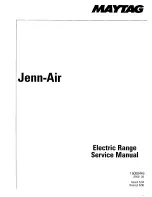
– 23 –
REGULATOR CHECK, ADJUSTMENT, INSTALLATION (Cont.)
2.
With only two open top burners “ON”, note the manometer reading. The reading should be 3.7" Water Column
(.92 kPa) for natural gas units and 10.0" Water Column (2.5 kPa) for propane gas units. If readings taken are lower,
check the incoming line pressure.
NOTE:
The line pressure should never drop below 5.0" Water Column (1.25 kPa)
for natural gas or 11.0" Water Column (2.7 kPa) for propane gas.
If line pressure is incorrect, it must be adjusted in order to properly operate the unit . If the line pressure is good, then
the regulator requires adjustment (refer to procedures for regulator adjustment).
If, after the regulator adjustment has been made, the 3.7" Water Column (.92 kPa) (natural gas) or 10.0" Water
Column (2.5 kPa) (propane gas) still is not being maintained, replace the regulator.
3.
With the regulator now reading 3.7" Water Column (.92 kPa) (natural gas) or 10.0" Water Column (2.5 kPa) (propane
gas), turn two open top burners “ON”.
4.
Recheck the pressure reading. The reading should not fluctuate more than ± .10" (0.7 kPa). If reading is not within
tolerance, replace the regulator.
NOTE:
When the burners are “OFF”, if the pressure reading climbs to an outlet regulator pressure stated in Step 2, check
the regulator vent for obstruction (Figs. 24 & 25).
Fig. 24
Fig. 25
Check also for gas leak at vent. If vent is leaking gas, replace the regulator.
REGULATOR ADJUSTMENT
TOOLS REQUIRED:
Flat blade screwdriver, manometer, and 6" adjustable wrench.
NOTE:
Before making a regulator adjustment, always verify that the incoming line pressure is correct. The required
incoming minimum line pressure for the Restaurant Range series is 5.0" (1.25 kPa) for natural gas and 11.0" (2.7 kPa)
for propane gas. If the line pressure is not correct, it must be rectified or the unit will not properly operate or achieve
proper regulator adjustment. Also, the regulator must be attached to the unit in the horizontal position with the arrow
pointing in the direction of the gas flow (see Fig. 7).














































